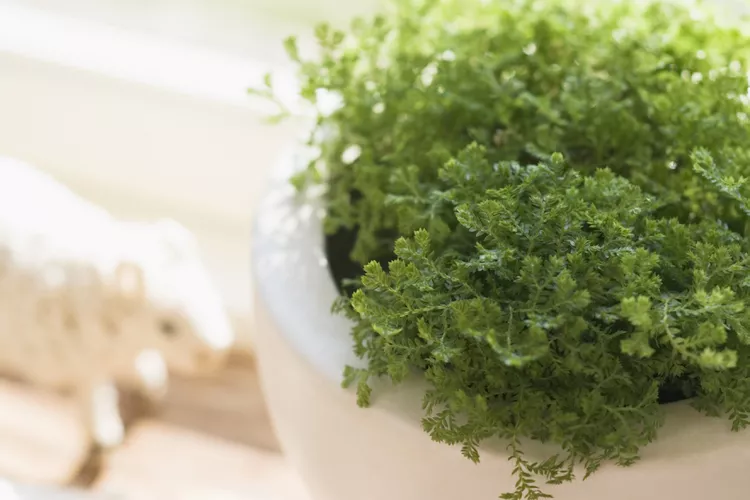Spike moss is a beautiful and delicate-looking, fern-like plant that deserves to be more widely grown. Most types only grow a couple of inches tall, slowly spreading to form a cushion of lacy green leaves and stems. These plants are best suited for more humid indoor locations like bathrooms and growing in terrariums. Besides needing relatively high humidity, spike moss will thrive with very little maintenance.
Spike Moss Overview
| Genus Name | Selaginella kraussiana |
| Common Name | Spike Moss |
| Plant Type | Perennial |
| Light | Part Sun |
| Height | 0 to 2 Feet |
| Foliage Color | Blue/Green, Chartreuse/Gold |
| Zones | 10, 8, 9 |
| Propagation | Stem Cuttings |
Where to Grow Spike Moss
Outside of warm, humid climates, spike moss is best kept as an indoor terrarium plant. Give these plants plenty of bright, indirect light near an east-facing window or just out of direct sunlight in a south-facing window. Terrariums don't need to be covered, but sealing the terrarium or other enclosures will help to increase humidity around the plant.
How and When to Plant Spike Moss
As with other indoor plants, spike moss can be planted at any time of the year. Due to their shallow root systems, a deep pot or container is not necessary. Make sure roots are covered, and water well after planting.
Care Tips for Spike Moss
Light
Spike moss grows well under bright, indirect light, but can survive in dimmer conditions. Never place plants in direct sun as they are likely to burn, which can severely hinder the plants' growth or even kill it.
Soil and Water
Plant spike moss in light, loamy soil with good water retention and excellent drainage. While these plants can handle periods of dryness, they do best when their soil is kept moist.
Temperature and Humidity
Spike moss prefers to grow in cool to warm conditions and will stop growing or die off when temperatures drop below freezing. Dry, hot temperatures should also be avoided, and high humidity is crucial to good growth.
Fertilizer
Very little fertilizer is necessary when growing spikemoss in soils rich in organic matter like compost. However, older, established plants can benefit from an organic liquid fertilizer once or twice a year while plants are actively growing.
Potting and Repotting
To pot or repot your spike moss, follow these steps:
- Remove the plant from the container by flipping it upside down and holding the plant with one hand and the pot/container with the other.
- Gently shake and or lightly squeeze the pot until the plant and root ball drop out.
- Using your free hand, dig a hole to about the depth and width of the root ball.
- Place the plant into the hole and replace the soil around the edges. Pat soil down gently and water to remove any air bubbles under the soil.
Pests and Problems
Spike moss is rarely bothered by pests, but is prone to root rot. While humidity should remain high, plants should never sit with their roots in water. If plants begin to rot from too much water, cut off rotting portions of plants and roots and transplant them into fresh potting soil. If the opposite happens and plants dry out too much, soak underwater for about a half hour and return to a location with high humidity.
How to Propagate Spike Moss
The easiest way to propagate spike moss is to through cuttings. Use a clean pair of scissors to cut through stems and gently remove rooted portions of the plant from the soil. Move cuttings into a new pot and lightly cover the roots in moist potting soil.
Types of Spike Moss
A common light green or yellowish form of Selaginella kraussiana is available under the variety name, ‘Aurea.’ These plants lack the normal amount of chlorophyll found in the species and can be somewhat less hardy. Give these plants very bright, but indirect light to provide enough energy for growth while avoiding burning them.
Another common variety is ‘Brownii,’ which produces thicker, mounding masses that spread much slower than other varieties.
Companion Plants for Spike Moss
Spike moss is somewhat slow-growing and remains low to the soil level. Grow them with less aggressive terrarium plants to avoid drowning them out. Smaller ferns such as tropical maidenhairs (e.g. Adiantum tenerum) and carnivorous plants like pitcher plants (Nepenthes spp.) work well because these plants also need high humidity and lots of moisture.




















